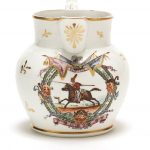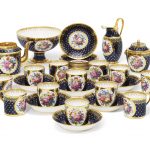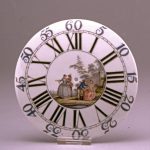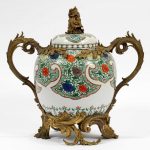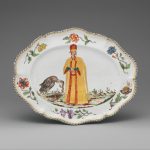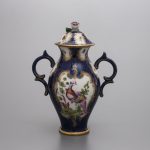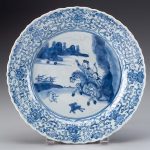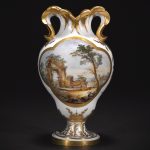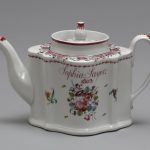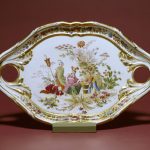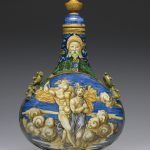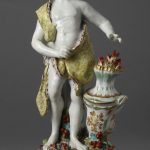Hard-paste porcelain is a ceramic material that was originally made from a compound of the feldspathic rock petuntse and kaolin fired at very high temperature, usually around 1400 °C. It was first made in China around the 7th or 8th century, and has remained the most common type of Chinese porcelain.
From the Middle Ages onwards it was very widely exported and admired by other cultures, and fetched huge prices on foreign markets. Eventually Korean porcelain developed in the 14th century and Japanese porcelain in the 17th, but other cultures were unable to learn or reproduce the secret of its formula in terms of materials and firing temperature until it was worked out in Europe in the early 18th century, and suitable mineral deposits of kaolin, feldspar and quartz discovered. This soon led to a large production in factories across Europe by the end of the 18th century. Reference: Wikipedia
A Coalport porcelain jug Circa 1814 In hybrid hard paste, printed under the spout and hand-painted with a Don Cossack following a sign to Paris, 13.3cm high
Sold for £ 250 inc. premium at Bonhams in 2018
A SEVRES (HARD PASTE) PORCELAIN DARK BLUE-GROUND TEA-SERVICE CIRCA 1810, RED STENCILLED M.IMP.LE DE SEVRES 10 MARK, GREEN PAINTED D 8 KILN MARKS, VARIOUS GILT SCRIPT GILDER’S MARKS AND INCISED MARKS Comprising: a teapot and cover, a sugar-bowl and cover, a milk-jug, a footed bowl, twelve cups and saucers The teapot – 5 ¼ in. (13.3 cm.) high
Sold for GBP 6,875 at Christies in 2018
Clock-dial; hard-paste porcelain; moulded; painted with four Watteau subjects, numbers in blue and Roman numerals in black and gold. Factory of: Meissen Porcelain Factory School of/style of: Antoine Watteau Date 1745-1750 (circa)
Reference: © The Trustees of the British Museum
CHINESE PORCELAIN FAMILLE VERT URN, FRENCH BRONZE ORMOLU 19TH.C. H 15.5″ :Important porcelain encapsulated in French bronze mounts. W. 15.5″. Hard paste porcelain later mounted in gilt bronze, Paris.
Sold for $1,000 at DuMouchelles in 2019
The second of the eighteenth-century Italian porcelain factories was founded in 1737 by the marchese Carlo Ginori (1702–1757) at Doccia, near Florence. Ginori sought the assistance of two men who had worked for the du Paquier factory in Vienna, and it is likely that porcelain was in production by about 1740. In the following year, Ginori obtained an exclusive privilege for the manufacture of porcelain in Tuscany. Due to the quality of the local supply of kaolin—a critical ingredient in the production of hard-paste porcelain—the porcelain made at Doccia was gray and slightly coarse, but the artistic level of Doccia’s production more than compensated for its technical deficiencies. This platter is one of three (06.372a–c) at the Museum decorated with a figure in exotic dress. This figure of a Turkish man is copied from a painting by Jacopo Ligozzi, which was based in turn on an illustration in Navigation and Voyages in Turkey, first published in 1576. The painted decoration is attributed to Johann Karl Wendelin Anreiter, a worker from the Du Paquier factory who aided Ginori in the founding of the Doccia factory. The precisely painted large flowers on the border and the distinctive palette of strong colors reflect the influence of the Viennese factory on Doccia porcelain.
Reference: The Metropolitan Museum of Art
Vase, Worcester type, hard-paste porcelain, Samson, Paris, France, c 1860 Rococorevival baluster vase with cover, white panels painted with exotic birds and insects in gilt cartouches set against a scale blue ground. Scroll side handles and domed cover with a flower finial.
Reference: Museum of Applied Art and Sciences
Dish Chinese export about 1700
Hard-paste porcelain. Chinese for export for the Continental Market. This Chinese porcelain dish made for export to Europe is similar to one that must have been available to the craftsmen at Meissen, where nearly identical plates were made. This particular hunting scene was popular in China and appears on other Chinese export porcelain. The high quality of painting suggests that the dish was not made for the East India Company, but instead for “private trade” by ship’s owners or agents.
Reference: Museum of Fine Arts Boston
A fine Sèvres (hard-paste) porcelain vase, 1773, painted by Nicolas Schradre vase à oreilles, of the third size, painted with a quatrefoil cartouche depicting the Arch of Drusus in an animated landscape of ancient ruins after Piranesi, the reverse side quatrefoil cartouche reserving a bouquet of flowers decorated with golden flower tinsels and foliage, crowned interlaced LL mark in red, date letter U for 1773, painter and gilder mark for Nicolas Schradre (active as a painter and gilder from 1773-1785), incised mark DP in cursive letters, 19.3cm., 7 5/8 in. high
Sold for 100,000 GBP at Sothbys in 2018
Teapot and cover of hard-paste porcelain painted with enamels and inscribed ‘Sophia Sayer 1803’.
The New Hall factory was set up in order to exploit the patent for making hard-paste porcelain which the partners had purchased. In this they succeeded well, by making tough but elegant tea wares. After about 1800, however, the increasing popularity of the new bone-china formula began to undermine the advantages that they had enjoyed.
Reference: © Victoria and Albert Museum
This tray is decorated with fanciful scenes of China, a dominant theme in French 18th-century art that reflects the fascination, fear, and awe of that country at the time. The scene was painted by Michel-Louis Chauveaux (active 1773–82). Jean Chauvaux the Younger decorated this white ground, hard-paste porcelain tray with a fanciful pseudo-Chinese scene, in which a woman holding an apple with one hand gestures with the other toward a prostrate youth at her side. Chauvaux might have drawn his inspiration for the scene from the work of François Boucher.
Reference: The Walters Art Museum
